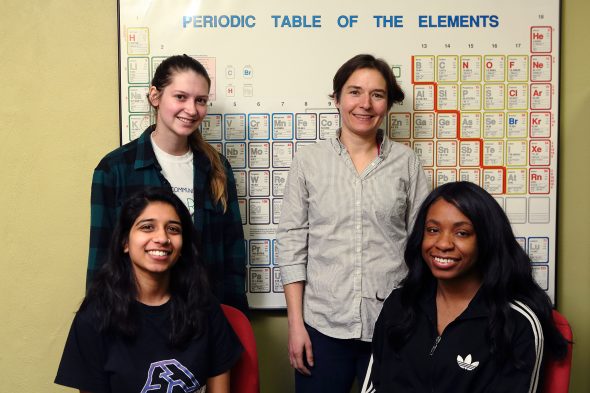East Meets West: Chemistry labs designed for nurses

Ginevra Clark (back row, right) with students Kamryn Czysz, junior in biochemistry, and (front row, from left) Kruti Bhatt, senior in psychology, and Stella Udoetuk, junior in biology. (Photo: Jenny Fontaine)
College chemistry labs are a requirement for science majors who want to work in health care. So why shouldn’t we prepare them now to think about chemistry concepts like a nurse or doctor would?
When Ginevra Clark came to UIC in 2011, a similar question was on her mind.
“I reached out to Maripat King in the College of Nursing just to find out what elements of chemistry are important for nurses,” said Clark, clinical assistant professor in chemistry. She teaches CHEM 130, survey of organic and biochemistry, a class that enrolls up to 150 undergraduates every semester. More than 90 percent of her students plan to work in a health-related field. “That’s where this project started,” she said.
The project is a reboot of the CHEM 130 curriculum, something that hadn’t been done for about 20 years. After working with campus collaborators, Clark created new labs for the course that bridge the gap between chemistry concepts taught in class and real-world situations that health care professionals deal with daily.
“We focused on acids and bases and equilibrium concepts,” said Clark, who is also the director of UIC’s Science Learning Center.
One lab lesson about dialysis, albumin binding and competitive binding shows why understanding those chemistry concepts matters when health care professionals administer different drug combinations, for example. For the lab, students place dye in a dialysis tube and observe the dye pass to the other side. The dye is passing through small pores in the dialysis tube, similar to how drugs pass through small pores in the capillaries — fine branches of blood vessels in the body. Then, they add albumin, a protein that binds to the dye. After binding, the dye becomes too large to pass through the pores. The dye passes through the dialysis tube more slowly, which is a model for how drugs bind to albumin in the blood and are released over time. Adding oleic acid to the solution makes the dye pass through more quickly, since oleic acid binds competitively to albumin. The final step illustrates what happens when deadly drug combinations like blood thinners and certain antibiotics are co-administered, which can cause major bleeding.
“We have this simple model for equilibrium that explains a biological phenomenon” said Clark. “Equilibrium is a chemical concept, so we can’t expect students to learn this in their biology courses.”
Other labs focus on urine dipstick tests; detection of neonatal respiratory distress; and even a sucrose intolerance test, which ties chemistry to cultural competency, Clark’s next big development in the modification of the labs. A total of 12 labs make up the curriculum.
The concepts covered by the labs are especially important in nursing practice, said Maripat King, Clark’s collaborator and clinical assistant professor of nursing. Students in CHEM 130 touch on topics that most don’t learn until their first year of nursing school.
“I can tell you just anecdotally these students have a better understanding than some of albumin, which we talk about extensively when we go over liver failure, cirrhosis, hepatitis,” King said.
For CHEM 130, she introduces topics in some prelab videos to help students see the value of chemistry. In the College of Nursing, she teaches medical surgical nursing.
Because some groups are more likely to develop certain disorders, the cultural piece is key, too.
“It’s important to understand cultural variation and be sensitive to that,” said King, who is also director of undergraduate clinical studies for the Chicago, Urbana and Springfield campuses. “For example, 95 percent of Native Americans are diabetic. To look at that and understand what the long-term complications there are, what kind of screening needs to be available, those types of things allow you to practice in a more whole holistic manner in terms of nursing care. Knowing how to aim your education and preventive care is huge going forward.”
Collaborator Marisha Humphries, associate professor of educational psychology, is studying CHEM 130 teaching assistants’ delivery of culturally competent teaching and how students respond.
“[TAs] get trained around how to implement issues of cultural competence, being more reflective themselves about the impact their own culture has on how they approach chemistry and their work,” Humphries said. “So, the work really starts there.”
They hope to create a science space where students feel supported and think differently about how science impacts people.
Other project collaborators include Cynthia Soto, director of the Native American Support Program; Donald Wink from UIC’s department of chemistry; and Patrick L. Daubenmire from Loyola University. Graduate and undergraduate students have also made significant contributions.
This summer, Clark will present her project at a symposium in Germany. She hopes to form more collaborations and push them forward.
“Ultimately, teaching is about helping students to achieve their own goals, and watching students become more successful is what makes this project worthwhile,” she said.
“By incorporating the cultural competence and social justice aspects, we hope to help students form meaningful connections between chemistry and their world. The goal of this project is to change the way we do science, to reflect more carefully on who benefits from science and to use our understandings to create a more equitable world.”
